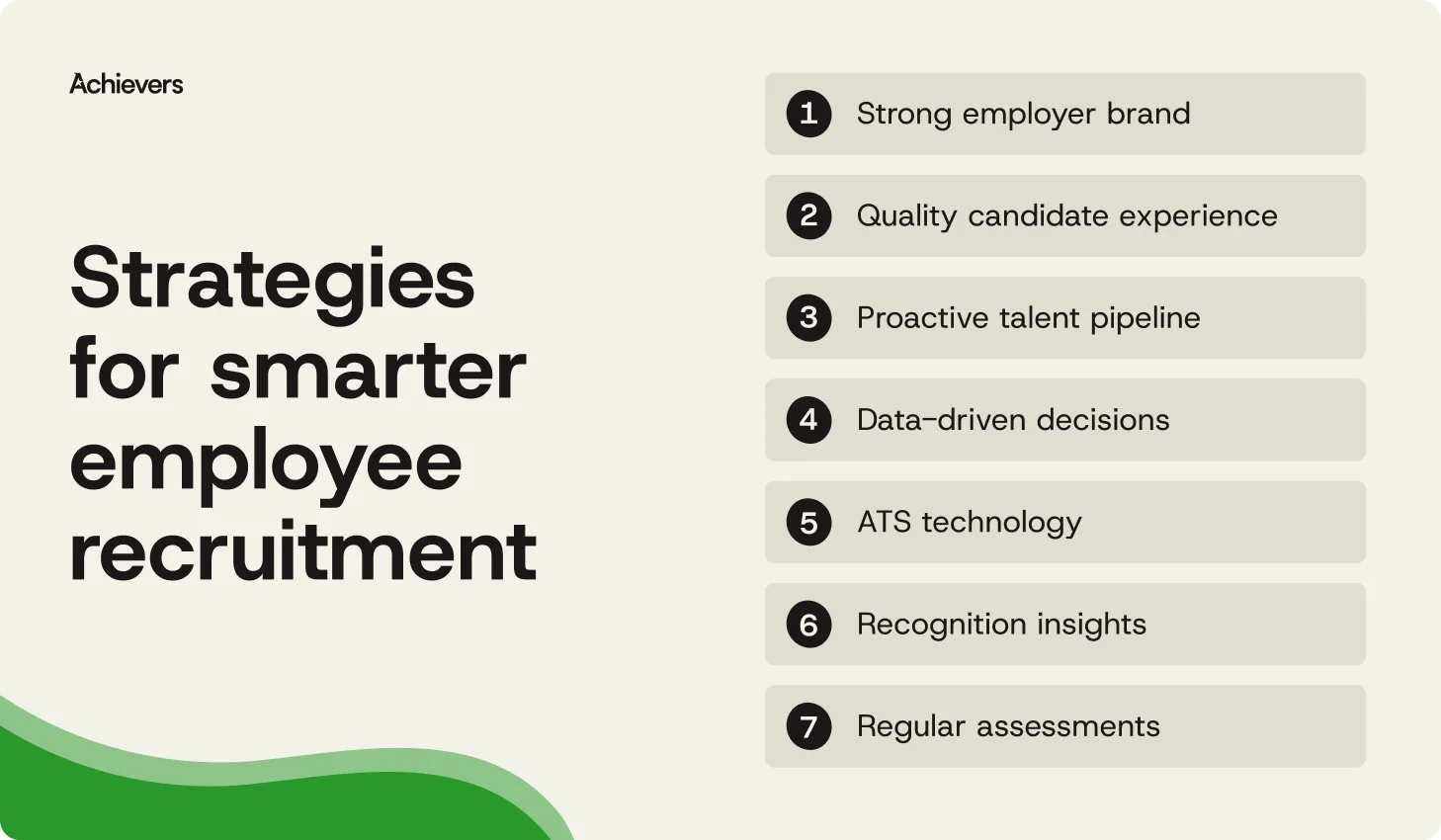Table of contents
You can’t build a great company without great people. Obvious, right? And yet, employee recruitment often gets treated like a rush job — a scramble to fill seats instead of a thoughtful strategy designed to shape the future of your workforce.
That shortcut mindset shows up in the numbers. According to Deloitte, the average turnover rate for new hires is 14%. Sure, people are getting through the door — but they’re not sticking around.
Hiring isn’t just about resumes and qualifications. It’s about finding people who want to do the work — and do it with you. That’s a higher bar. And it’s why the best recruitment strategies don’t stop at sourcing. They connect hiring with purpose, experience with culture, and brand with behavior.
In this guide, we’re breaking down what great employee recruitment really takes — from building a standout brand to making every candidate touchpoint count. No fluff, just what works.
The 9 stages of employee recruitment
Recruiting the right people doesn’t happen by accident — it’s a process. And every stage plays a role in shaping not just who you hire, but how they experience your organization from the very start.
Here’s how a strong recruitment process typically unfolds:
1. Find a vacancy
It starts with a need — maybe someone’s moved on, maybe your team’s growing, or maybe you’ve realized it’s time to stop stretching your current people too thin. This stage is about defining the role, aligning stakeholders, and clarifying what success looks like.
2. Craft the job description
A good job description does more than check boxes. It gives people a real feel for your team — what you value, how you work, and how you support your people. If you have a recognition-rich culture or strong development focus, say it. Candidates want to know what they’re walking into.
3. Promote the role
Once you’ve nailed the messaging, it’s time to get the word out. That might mean job boards, social media, or industry-specific platforms. The key is to meet the right candidates where they are — and make sure your employer brand shows up loud and clear in the process.
4. Review applications
This is where your team filters through resumes, cover letters, and portfolios to find the strongest fits. Applicant tracking systems (ATS) can help streamline the process, but it’s also about reading between the lines and looking for potential.
5. Conduct interviews
Interviews are your chance to connect. You’re not just assessing skills — you’re exploring fit, communication style, and alignment with your company’s core values. And they’re doing the same.
6. Check references and background
Before you make the offer, verify the essentials. Past experience, background checks (if needed), and reference calls help confirm your decision.
7. Make the offer
When you’ve found the right fit, clarity is key. Make the offer compelling and transparent. And remember: onboarding is part of the offer experience, too.
8. Recognize early, retain longer
Recognition doesn’t need to wait for a milestone. A warm welcome or a shoutout in their first week goes a long way. It shows new hires they’re seen, appreciated, and part of something from day one. And that kind of momentum boosts retention, confidence, and connection.
9. Onboard with intention
The offer’s signed — now it’s time to follow through. Onboarding is your chance to show new hires that they made the right call. Give them what they need to hit the ground running, introduce them to real company culture (not just the slide deck), and recognize their early contributions. A strong start builds trust, connection, and momentum — and it sets the tone for everything that comes next.
Strategies for smarter employee recruitment
Recruiting today isn’t just about filling roles — it’s about shaping the future of your workforce. And that means every step, from your brand reputation to your post-interview follow-up, needs to work smarter, not harder.
Whether you’re building a talent pipeline or optimizing with data, these strategies are here to help you attract the right people—and keep them feeling seen, heard, and appreciated from day one. Let’s dig in (no shovel required).

1. Develop a strong employer brand
People want to know what it’s really like to work at your company. A clear employer brand gives them that picture. Show up consistently, highlight your values, and give people a reason to choose you.
2. Deliver a quality candidate experience
Every touchpoint matters. Communicate clearly, be respectful of time, and leave people better off for having interacted with your brand — even if they don’t get the job.
3. Build a proactive talent pipeline
Don’t wait until there’s an opening. Stay connected with high-potential candidates and make sure hiring managers have a clear view of future needs.
4. Use data to guide your decisions
Recruiting gets sharper with data. Track what channels perform, where candidates drop off, and how new hires perform once they’re in-seat.
5. Leverage tech that actually helps
A good applicant tracking system (ATS) can keep your hiring process organized, collaborative, and way less chaotic. Choose one that fits your workflow — and if it integrates with your recognition platform or engagement tools, even better. That way, the experience stays connected from the moment they hit ‘apply’ to day one.
6. Use recognition insights to improve your recruitment strategy
Recognition data isn’t just for engagement — it tells you what success looks like. Use it to guide your hiring criteria, identify high-performing teams, and shape job descriptions around real behaviors that drive impact.
7. Regularly assess and improve your process
Recruitment isn’t static. Teams change. Markets shift. Make space for reflection. Look at the data, listen to feedback, and adapt. Recognition and performance insights can help you see where your process is working — and where it needs a reset.
Where recognition meets recruitment
Recognition says a lot about a company — and candidates are paying attention. When it’s meaningful, consistent, and tied to real values, it gives people a glimpse into what working at your organization feels like.
That has ripple effects across the entire recruitment process. According to Achievers Workforce Institute (AWI), employees who are recognized at least once a month are:
- 80% more likely to recommend their company as a great place to work
- 63% less likely to be thinking about leaving
- 84% more likely to say they’re their most productive self at work
These numbers point to a culture where people feel valued and do their best work. Recognition insights give hiring teams a clearer picture of what great looks like — and how to find more of it.
Improve the employee recruitment experience at your organization
Great recruitment doesn’t end with a signed offer — it’s the start of something bigger. To attract the right talent and keep them engaged long term, you need more than a strong hiring process. You need an employee experience that delivers on the promise you make during recruitment.
That’s where Achievers comes in. We help organizations build cultures where recognition is frequent, feedback is actionable, and people feel like they belong — from day one. Whether you’re looking to sharpen your employer brand, improve onboarding, or create stronger connections across teams, we’ll help you turn your workplace into one people want to join — and stay in.



